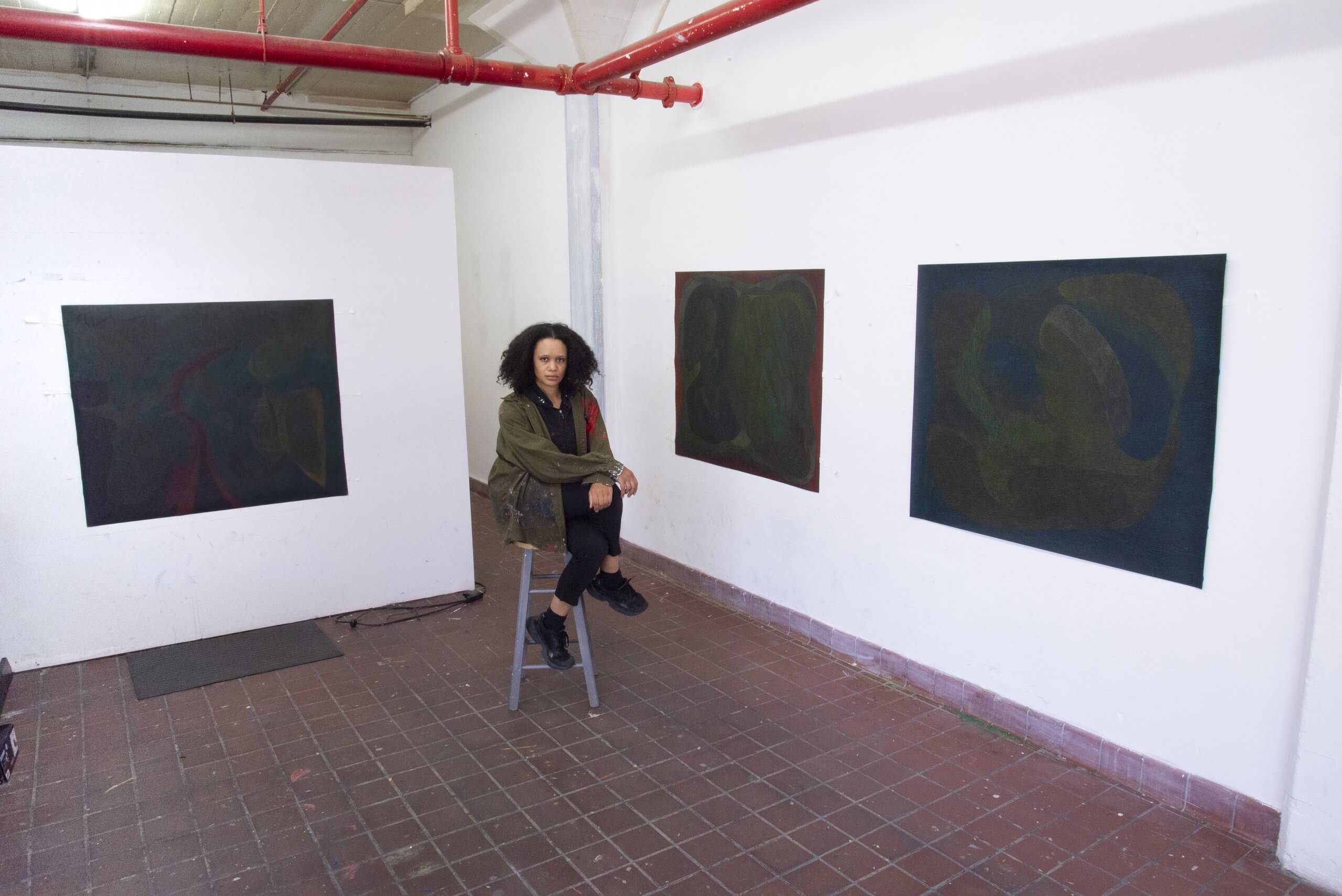
Angie Jennings at Bread & Salt Residency, San Diego, CA, 2021.
Angie Jennings explores the limits and structures of our visible spectrums in relation to identity and the unknown through her emanant drawings on black paper and sculptures. On the occasion of our current exhibition Angie Jennings: Guides from the night fields (July 21–August 31, 2021), we spoke with the artist about her work.

Angie Jennings, Blackhole, 2021, chalk pastel on paper, framed, 23 x 29 in. (58.4 x 73.7 cm.).
Q: As a visitor enters the gallery space, your 2021 chalk pastel drawing Blackhole looms overhead as an entrance and exit point. Thus, the first and last work a visitor sees in your exhibition is a depiction of a phenomenon that had long been invisible until 2017. How do you hope this bookend will affect a viewer’s perception of your show?
A: Right, with the placement I think people might miss the Blackhole entirely as they enter the gallery, since its placed so close to the ceiling. The placement echoes my interest in identity politics and the circumstance of being looked or passed by in reference to otherness.
We could also say the placement is in conversation with the dynamics of space. In connection with the other works in the show, the Blackhole acts as an entry point into spaces unknown or the imaginative spaces I’ve cultivated in reference to thinking about the limits of our perception and questioning what other planes could possibly exist. And of course, here we have the symbolic notion of making the invisible visible in reference to identity.
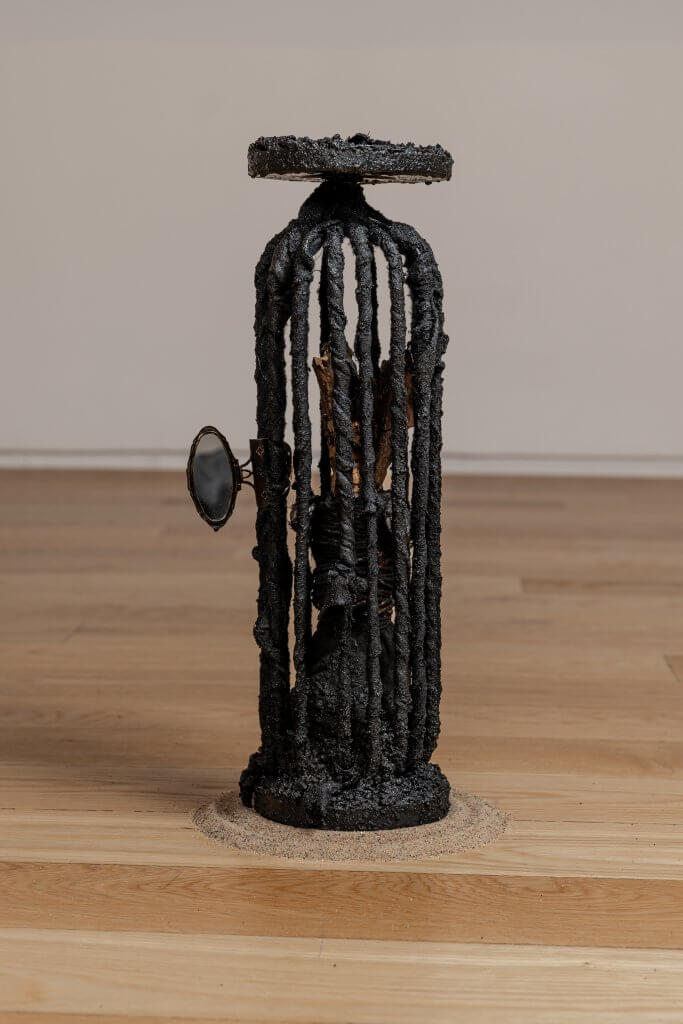
Angie Jennings, Untitled, 2021, found metal structure, found fabric, decomposed granite, wood, mirror, acrylic, resin, 16 x 4 x 4 in. (40.6 x 10.2 x 10.2 cm.).
Q: In comparing your bocio sculptures with the traditional anthropomorphic bocio, your rendition resists figural representation. Instead, your sculptures extract and highlight classical elements of bocio like binding, cords, mirrors, and wood. How does focusing on the abstract, symbolic elements of this traditional African Vodun sculpture aid you in addressing histories of colonization and its lingering states?
A: Right, well the sculptures I’ve made exist in dual states. They speak back to the Western canon of abstraction and serve as a puncture or punctuation to the many forms of inspiration that came from cultures and people with whom many of the early European masters of abstraction were not personally affiliated. Like did Picasso have any African friends? I mean Les Demoiselles d’Avignon is considered one of the most significant paintings in modern art and revered in grand esteem, but isn’t this a case of appropriation? Has this conversation already been had, or did I miss it?
There’s also a connection to the history of looted African works and artifacts brought to Europe and the United States, which I’m also linking to say the looting of Black bodies. This provides another example of both fetishization and colonization, which also brings up contemporary and cultural forms of exploitation. In addition, the sculptures function as a small attempt to reclaim erasures of my family history via enslavement in the states in reference to my West African ancestry, which I’ve verified through ancestry.com.
That said, there’s also a great connection that bocio have to the spiritual realm, for they’re often used to aid in protection and are thought to have the ability to converse with spirits. I found this history and concept very intriguing in connection to my new drawings and establishing spaces of reprieve in reference to the Green Book and to the idea of protective guides existing in open space.
Initially, I was very taken with the ways in which earth materials are used to form bocio, for many of my previous paintings on fabric include earth materials mixed into the paint including compost, mulch, and sand. At the time, my interest in combining earth materials with paint mainly stemmed from the relationship found between the exploitation of earth and that of the othered body, which is an idea I’m still very much interested in exploring.
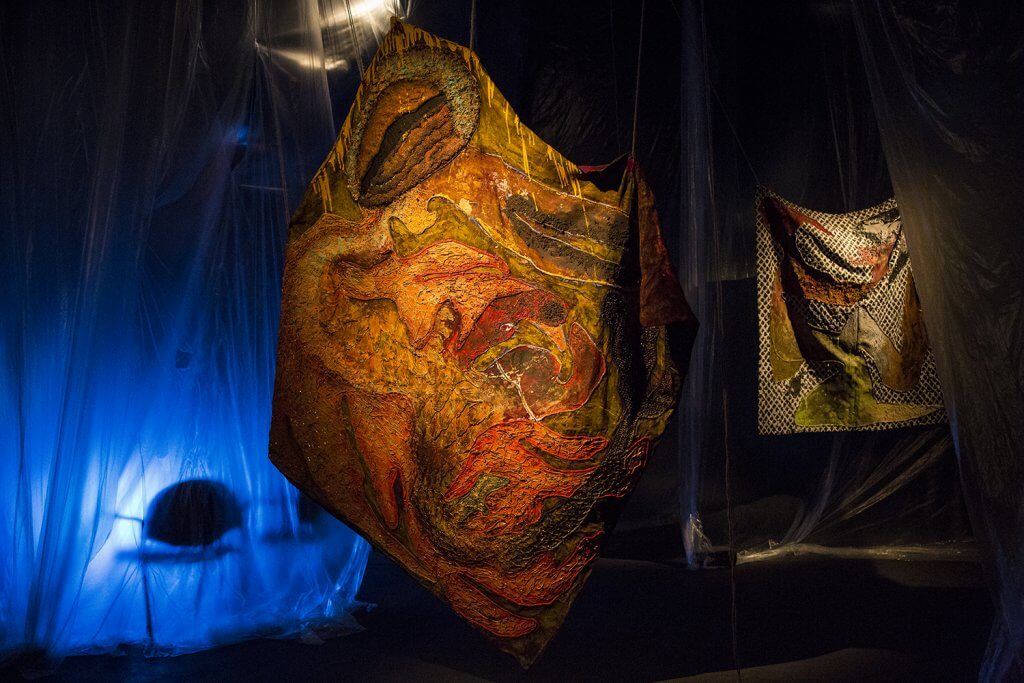
Angie Jennings, Velvet, 2016, mixed media on duvet cover, 79 1/4 x 79 1/4 in. (201.2 x 201.2 cm.)
Installation view from STIGMA FOG, 2016, University of California San Diego.
Q: When looking closely at your 2021 colored pencil drawing Below the light, biomorphic blue-green and red forms emerge from beyond the light’s rays. How do you envision the space beyond and “below the light” here?
A: I think Below the light is more about one’s personal experience, and questioning ways in which we perceive our surroundings. There are thoughts on visibility here and thinking through circumstances where it’s safer or more comfortable to stay below or out of sight. Depending on who you are and what spaces you navigate, one’s visibility can unfortunately often function as a target.
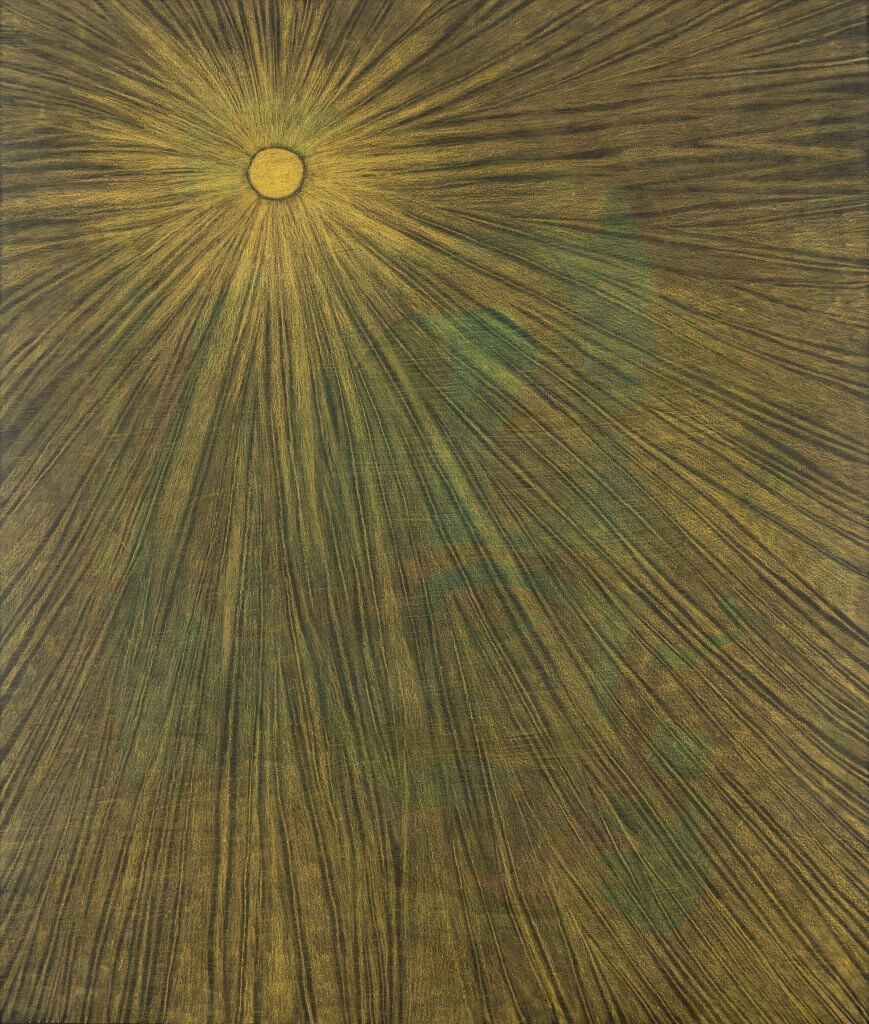
Angie Jennings, Below the light, 2021, colored pencil on paper, framed, 50 x 42 in. (127 x 106.7 cm.).
Q: Can you share some insight into the titles of your drawings such as Gatekeepers, With a child, To the underground, and Metamorphosis?
A: Usually titles come very quickly to me while looking at the work when it’s close to completion. With these drawings though, I was unable to form titles in my usual fashion. But I think similarly to a lot of artists the titles came from meditating upon the conceptual ideas on hand and examining what I thought I was looking at. I’m unsure if these titles are needed for this show, and perhaps I should have kept them a secret. The titles in a way might reveal too much of my own interpretation, which seems to be a bit in conflict with say wanting the viewer to interpret the work a bit more freely.
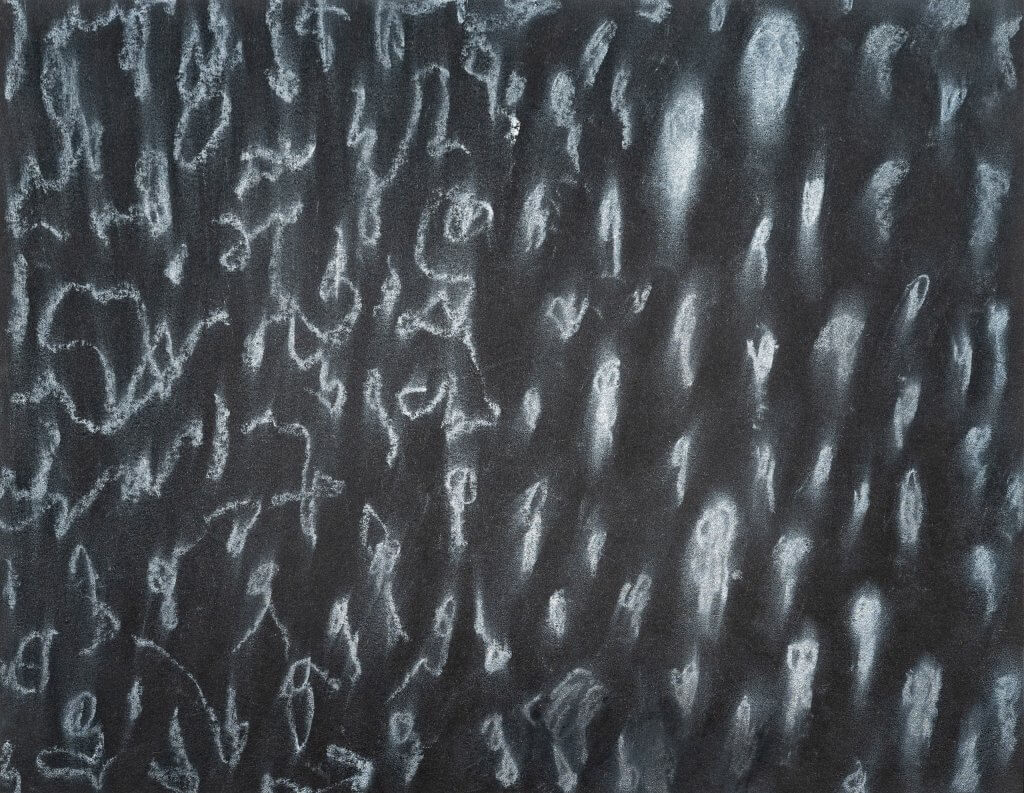
Angie Jennings, Unnamed Spirit Drawing 5/5, 2021, chalk pastel on paper, framed, 8 1/2 x 11 in. (21.6 x 27.9 cm.).
Q: Five Unnamed Spirit Drawings are placed low on the walls. What is your process in visualizing and drawing your Unnamed Spirit Drawings? Who are these spirits, what is their purpose, and/or can you elaborate on why the spiritual realm in which they exist is low to the ground?
A: Yes, well that goes back to thinking about other realms of existence that we don’t have visual access to. These drawings are very improvisational, and the outcomes were very unexpected. The works imbue a performative aspect where chance or the unknown has space to intervene. The placement of the spirit drawings encourages the viewer to move in the space a bit differently, crouching and weaving their way through. I suppose the placement acts as a form of encouragement in efforts to spend time contemplating the unseen.
With that, a lot of my interest in say the ‘afterlife’ has grown in part due to all the untimely deaths occurring over recent years. You could say there’s a connection to visionary art in reference to transcending planes.
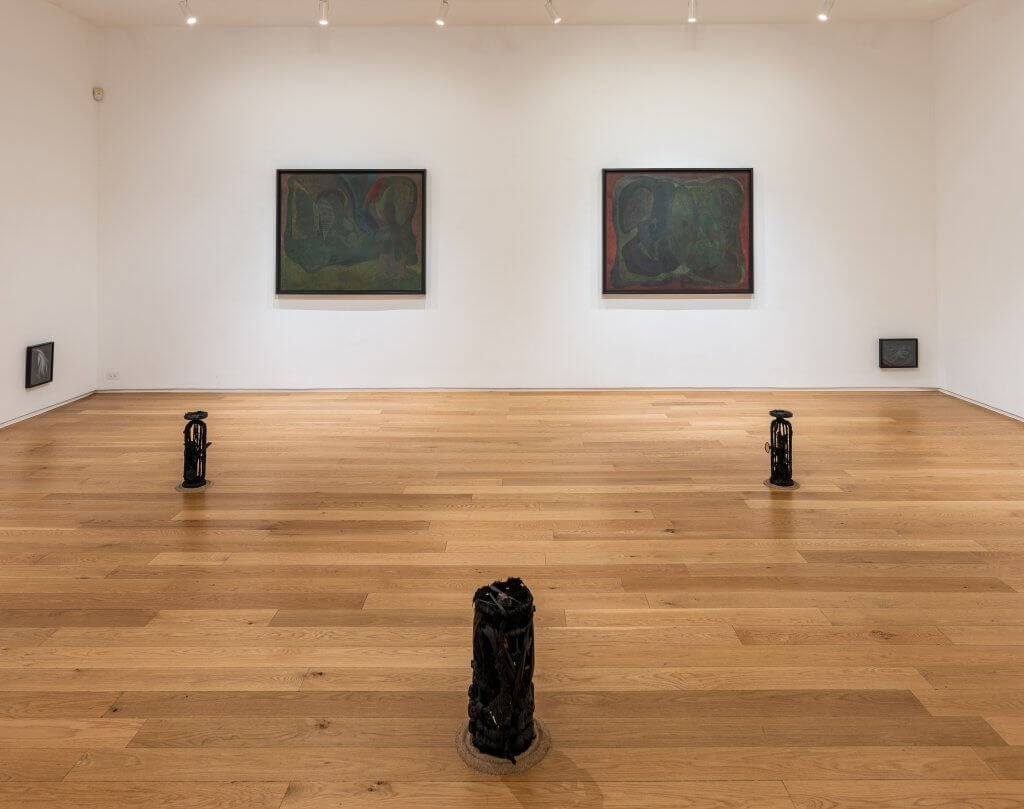
Installation view of Angie Jennings: Guides from the night fields (July 21–August 31, 2021) at Alexander Berggruen, NY.
Photo: Bryan Toro.